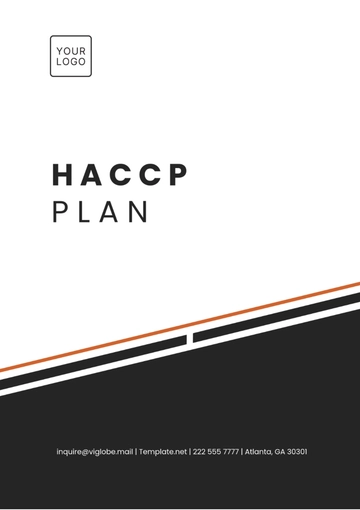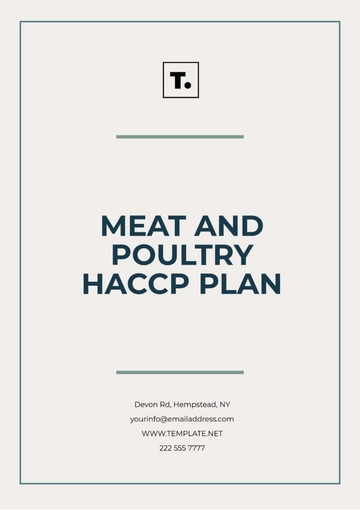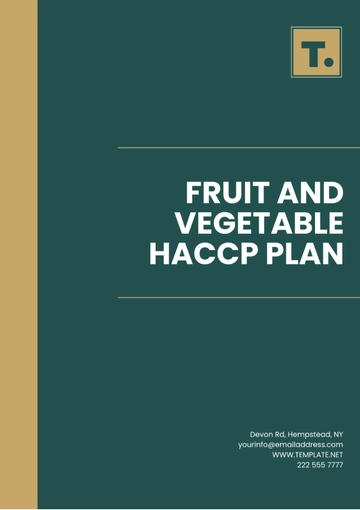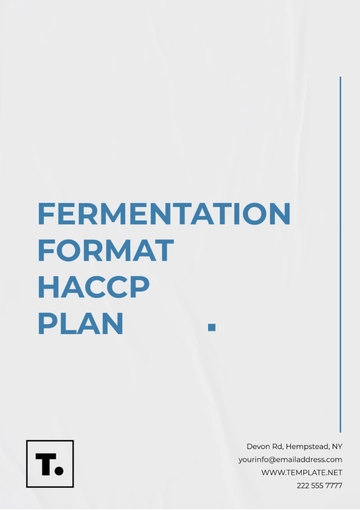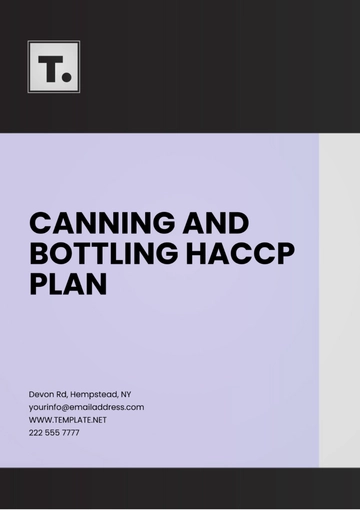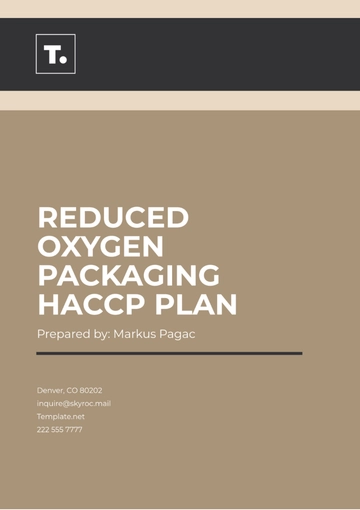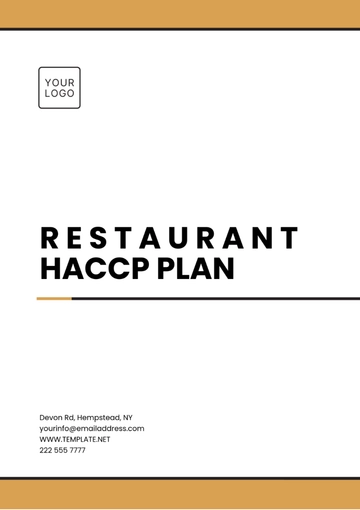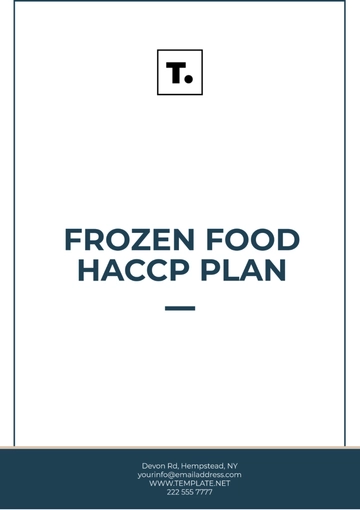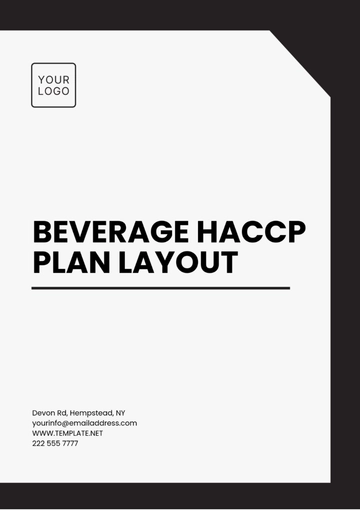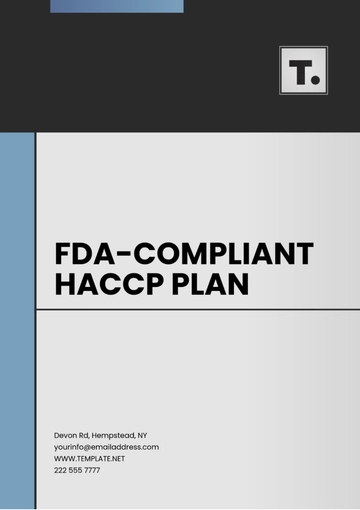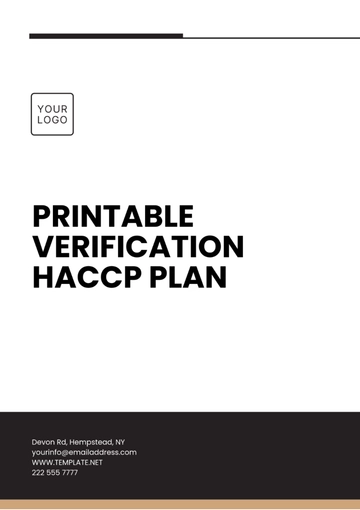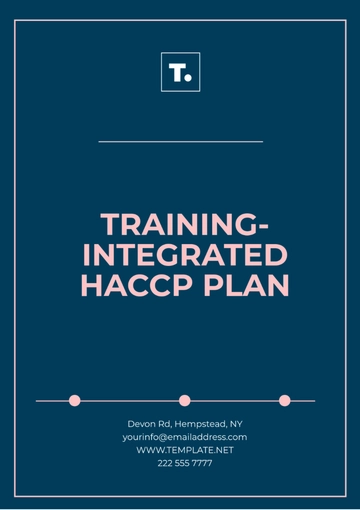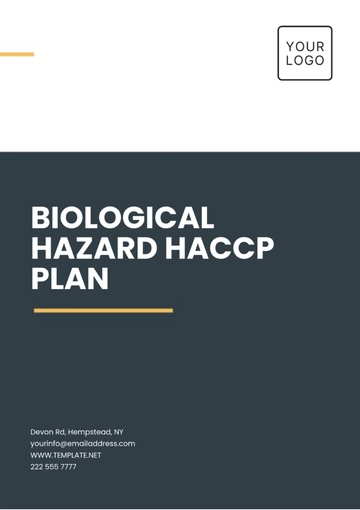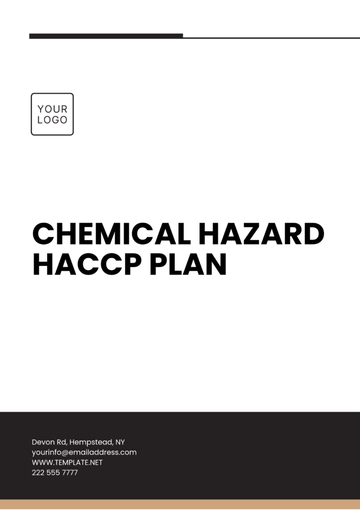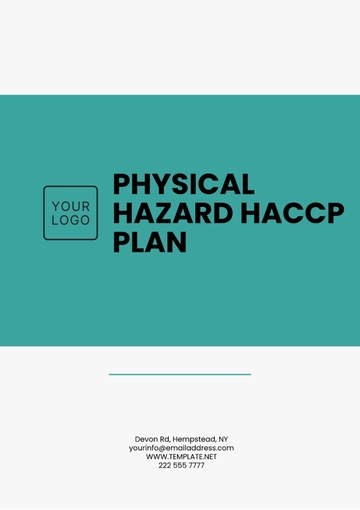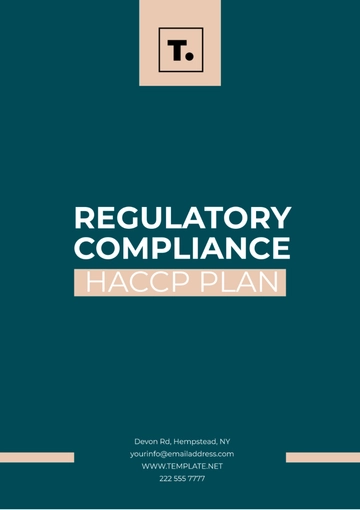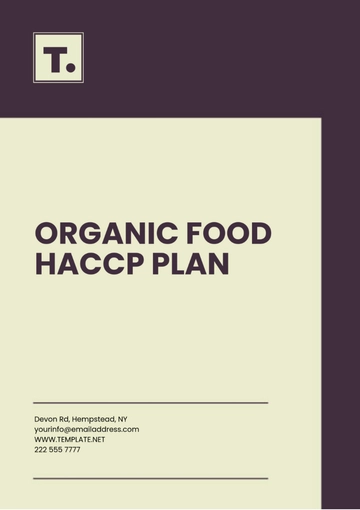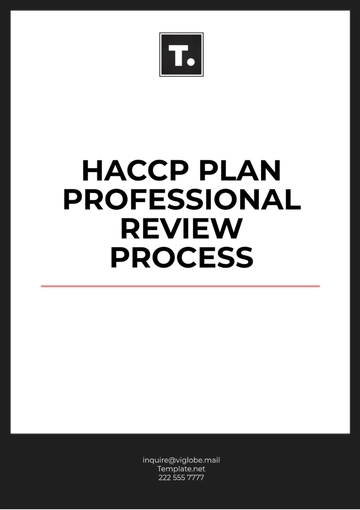Free Biological Hazard HACCP Plan
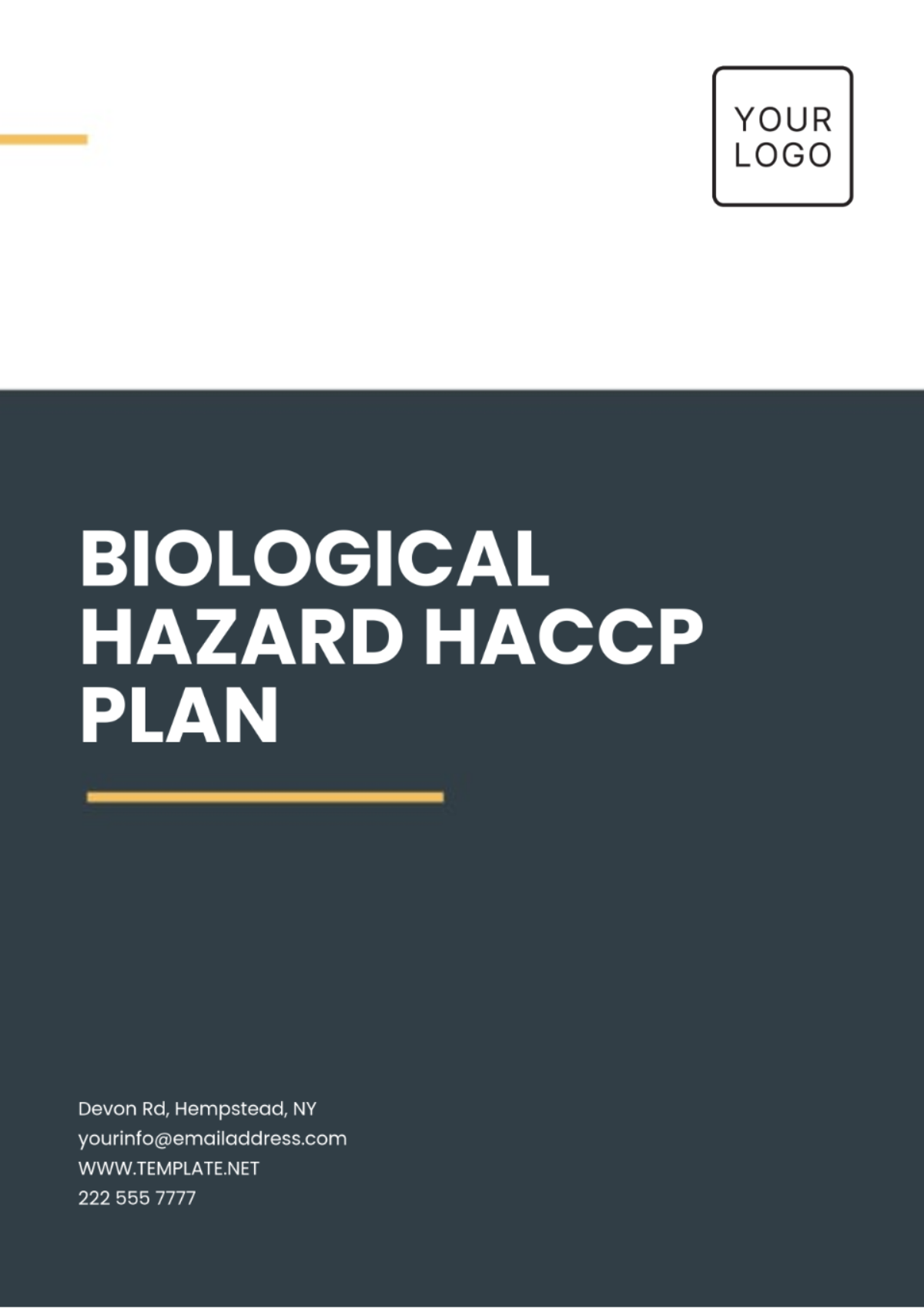
Date: March 28, 2060
Prepared by: [YOUR NAME]
I. Hazard Analysis
This section identifies and assesses potential biological hazards throughout the production process. The goal is to pinpoint microbial, viral, parasitic, and other biological risks that could compromise food safety and product quality. This analysis is crucial for developing preventive measures at appropriate stages.
Bacterial Contamination: Pathogenic bacteria such as Salmonella, E. coli, and Listeria monocytogenes can cause serious foodborne illnesses if not controlled effectively.
Viral Contamination: Foodborne viruses like Norovirus and Hepatitis A can be introduced through contaminated raw materials or improper handling by infected workers.
Parasitic Contamination: Parasites such as Toxoplasma gondii and Trichinella spiralis may be present in improperly processed meat or animal products, posing significant health risks.
Fungal Contamination: The production of mycotoxins by fungi like Aspergillus spp. or Fusarium spp. can lead to toxic effects if these contaminants are not detected and controlled.
II. Critical Control Points (CCPs)
Critical Control Points are specific steps in the production process where controls are essential to prevent, reduce, or eliminate biological hazards. Effective management of these points is crucial for ensuring product safety.
Raw Material Receiving: Inspection and testing of incoming materials to ensure biological safety, including pathogen-free certification from suppliers.
Cooking: Proper application of heat to eliminate harmful microorganisms. This step ensures that any biological contaminants present are destroyed before further processing.
Cooling: Immediate and proper cooling after cooking to prevent the growth of remaining bacteria or the introduction of new contaminants. Time and temperature control is critical to halt pathogen growth.
Packaging: Ensuring that packaging materials are sterile and the packaging process is conducted in a contamination-free environment to prevent the introduction of biological hazards after cooking and cooling.
A. Raw Material Receiving
All raw materials must be inspected and tested for the presence of biological hazards. Suppliers should provide certification proving that materials meet safety standards. Regular sampling and laboratory testing of incoming materials are recommended.
B. Cooking
A heat treatment process must be applied that is capable of killing pathogens. The exact cooking temperature and duration depend on the product, but a minimum internal temperature of 165°F (73.9°C) held for 15 seconds is generally required for most food products.
C. Cooling
Rapid cooling is necessary to prevent the growth of surviving bacteria. Products should be cooled from 140°F (60°C) to 70°F (21°C) within two hours, and then from 70°F to 41°F (5°C) or below within four hours.
D. Packaging
Ensure that all packaging materials are sterile and stored in clean conditions. The packaging environment must be tightly controlled to prevent unauthorized contact with contaminants, including human handling, airborne particles, and equipment contamination.
III. Critical Limits
Critical limits are the specific safety thresholds for each CCP. If these limits are exceeded, corrective actions must be taken to prevent a hazard from compromising product safety.
CCP | Critical Limit |
|---|---|
Raw Material Receiving | Materials must be accompanied by certifications proving they are free from specified pathogens, with periodic microbiological testing for verification. |
Cooking | The internal temperature of the product must reach at least 165°F (73.9°C) for a minimum of 15 seconds to ensure pathogen destruction. |
Cooling | Cooling must bring the product from 140°F (60°C) to 70°F (21°C) within 2 hours, and then down to 41°F (5°C) or lower within an additional 4 hours. |
Packaging | No direct or indirect contact with contaminants; packaging must occur in a controlled, sanitary environment. |
IV. Monitoring Procedures
Monitoring ensures that CCPs are maintained within the established critical limits. Continuous observation and documentation of these processes are necessary to detect deviations promptly.
Thermometer checks: Regular temperature measurements during cooking and cooling to ensure critical limits are met.
Visual inspections: Routine inspections of packaging materials and environments to check for contamination risks.
Sampling and testing: Periodic microbiological testing of raw materials and final products to confirm the absence of biological hazards.
Automated monitoring systems: Where applicable, automated temperature logging systems can be used to track and document cooking and cooling processes.
V. Corrective Actions
Corrective actions must be taken immediately when monitoring indicates that a critical limit has been exceeded. These actions aim to contain the hazard and prevent contaminated products from reaching consumers.
Re-cook: If the cooking temperature does not reach the required limit, the product must be re-cooked to the correct temperature.
Refrigerate: If cooling is delayed or ineffective, increase the cooling system's efficiency by using additional equipment or adjusting environmental conditions.
Reject: Contaminated raw materials that do not meet biological safety standards must be rejected and removed from production.
Investigate and prevent recurrence: Determine the cause of the deviation and implement preventive measures to avoid future breaches.
VI. Verification Procedures
Verification ensures that the HACCP system is functioning effectively and that the established control measures are being followed correctly.
Regular review of monitoring records: Check temperature logs, inspection reports, and test results to verify that CCPs are consistently controlled.
Annual validation tests: Conduct laboratory tests and process evaluations to confirm that the HACCP plan's preventive measures are effective in controlling biological hazards.
Third-party audits: Schedule periodic audits by external experts or regulatory bodies to verify compliance with food safety regulations and industry best practices.
VII. Record-Keeping
Comprehensive record-keeping is essential to demonstrate that all controls, monitoring, and corrective actions have been properly implemented and documented.
Daily temperature logs: Maintain detailed records of cooking and cooling temperatures, ensuring compliance with critical limits.
Deviation reports: Document any CCP deviations and corresponding corrective actions taken.
Audit and inspection reports: Keep records of internal audits, third-party audits, and any inspection outcomes to demonstrate ongoing compliance.
- 100% Customizable, free editor
- Access 1 Million+ Templates, photo’s & graphics
- Download or share as a template
- Click and replace photos, graphics, text, backgrounds
- Resize, crop, AI write & more
- Access advanced editor
Address biological hazards effectively with this Biological Hazard HACCP Plan Template from Template.net. This editable and customizable template provides a detailed guide for identifying and managing biological hazards in your food production processes. Editable in our Ai Editor Tool, you can easily adapt it to fit the specific biological threats relevant to your facility.
You may also like
- Finance Plan
- Construction Plan
- Sales Plan
- Development Plan
- Career Plan
- Budget Plan
- HR Plan
- Education Plan
- Transition Plan
- Work Plan
- Training Plan
- Communication Plan
- Operation Plan
- Health And Safety Plan
- Strategy Plan
- Professional Development Plan
- Advertising Plan
- Risk Management Plan
- Restaurant Plan
- School Plan
- Nursing Home Patient Care Plan
- Nursing Care Plan
- Plan Event
- Startup Plan
- Social Media Plan
- Staffing Plan
- Annual Plan
- Content Plan
- Payment Plan
- Implementation Plan
- Hotel Plan
- Workout Plan
- Accounting Plan
- Campaign Plan
- Essay Plan
- 30 60 90 Day Plan
- Research Plan
- Recruitment Plan
- 90 Day Plan
- Quarterly Plan
- Emergency Plan
- 5 Year Plan
- Gym Plan
- Personal Plan
- IT and Software Plan
- Treatment Plan
- Real Estate Plan
- Law Firm Plan
- Healthcare Plan
- Improvement Plan
- Media Plan
- 5 Year Business Plan
- Learning Plan
- Marketing Campaign Plan
- Travel Agency Plan
- Cleaning Services Plan
- Interior Design Plan
- Performance Plan
- PR Plan
- Birth Plan
- Life Plan
- SEO Plan
- Disaster Recovery Plan
- Continuity Plan
- Launch Plan
- Legal Plan
- Behavior Plan
- Performance Improvement Plan
- Salon Plan
- Security Plan
- Security Management Plan
- Employee Development Plan
- Quality Plan
- Service Improvement Plan
- Growth Plan
- Incident Response Plan
- Basketball Plan
- Emergency Action Plan
- Product Launch Plan
- Spa Plan
- Employee Training Plan
- Data Analysis Plan
- Employee Action Plan
- Territory Plan
- Audit Plan
- Classroom Plan
- Activity Plan
- Parenting Plan
- Care Plan
- Project Execution Plan
- Exercise Plan
- Internship Plan
- Software Development Plan
- Continuous Improvement Plan
- Leave Plan
- 90 Day Sales Plan
- Advertising Agency Plan
- Employee Transition Plan
- Smart Action Plan
- Workplace Safety Plan
- Behavior Change Plan
- Contingency Plan
- Continuity of Operations Plan
- Health Plan
- Quality Control Plan
- Self Plan
- Sports Development Plan
- Change Management Plan
- Ecommerce Plan
- Personal Financial Plan
- Process Improvement Plan
- 30-60-90 Day Sales Plan
- Crisis Management Plan
- Engagement Plan
- Execution Plan
- Pandemic Plan
- Quality Assurance Plan
- Service Continuity Plan
- Agile Project Plan
- Fundraising Plan
- Job Transition Plan
- Asset Maintenance Plan
- Maintenance Plan
- Software Test Plan
- Staff Training and Development Plan
- 3 Year Plan
- Brand Activation Plan
- Release Plan
- Resource Plan
- Risk Mitigation Plan
- Teacher Plan
- 30 60 90 Day Plan for New Manager
- Food Safety Plan
- Food Truck Plan
- Hiring Plan
- Quality Management Plan
- Wellness Plan
- Behavior Intervention Plan
- Bonus Plan
- Investment Plan
- Maternity Leave Plan
- Pandemic Response Plan
- Succession Planning
- Coaching Plan
- Configuration Management Plan
- Remote Work Plan
- Self Care Plan
- Teaching Plan
- 100-Day Plan
- HACCP Plan
- Student Plan
- Sustainability Plan
- 30 60 90 Day Plan for Interview
- Access Plan
- Site Specific Safety Plan
